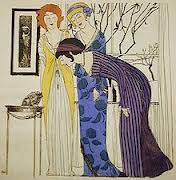''The Gibson Girl was tall and slender, yet with ample bosom, hips and bottom. She had an exaggerated S-curve torso shape achieved by wearing a swan-bill corset. Images of her epitomized the late 19th- and early 20th-century Western preoccupation with youthful features and ephemeral beauty. Her neck was thin and her hair piled high upon her head in the contemporary bouffant, pompadour, and chignon ("waterfall of curls") fashions.''
The S-Bend
At the beginning of the Edwardian era a new style of corset cam into style, the S-bend.
The S-bend was a type of corset that was so tight that made you appear to have a very skinny waist and big hips.
The S-bend was very damaging to the womens internal organs because they were wearing the corsets for at least 10 hours a day which meant that their organs were getting squashed. Women were only allowed to take their corsets of for a few hours a day. When they weren't wearing their corset they would wear a tea dress.
A tea dress was a loose fitting dress that women could wear while having their afternoon tea.
The Hobble Skirt
The hobble skirt was a skirt with a very narrow hem. It was designed to shorten the wearers stride.
The Parisian fashion designer Paul Poiret is sometimes credited with the design, inspired by the widespread Oriental influence on Western culture, but in fact the extreme hobble skirt is an evolution of the narrowing skirt seen in fashion since the turn of the century.
Wide Brimmed Hats were also very popular during these times.
Marc Jacobs A/W12 collection featured alot of wide brimmed hats.

























